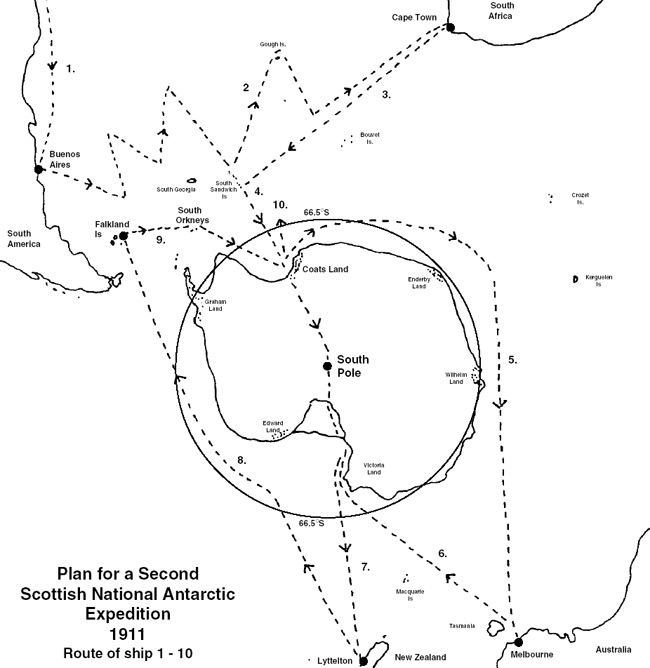
| Glasgow Digital Library | Voyage of the Scotia | BRUCE | PEOPLE | SHIP | ANTARCTIC | INDEX |
|---|
In 1908 Bruce produced plans for a second Antarctic expedition to follow up on the work of the Scotia expedition. No other expedition had gone to the Weddell Sea since Bruce's return. Bruce even hoped he could use Scotia again. The route is shown on the map.
In 1910 Bruce announced his final plan to the Royal Scottish Geographical Society. The cost would be £50,000 and he proposed to sail in 1911. There was a lot of support from the scientific community and several Scotia staff were willing to return. There was no financial backing for this trip - despite the inclusion of a polar journey at a time when these were very popular with the public.
In 1913 Bruce discussed his polar plans with Nordenskjold (of Antarctic fame), Stefansson (who led the disastrous 1913-14 Canadian Arctic expedition - the ship was crushed in the ice about the same time as Shackleton's Endurance, but half the crew were to die) and Peary (who had been to the North Pole in 1909).
In 1913 the totally unexpected news of the death of Scott's party on the return from the South Pole reached Britain.
'The World was thrilled by Scott's great achievement and the simple heroism of the end.'
William Speirs Bruce
Bruce refused to be drawn into a discussion of Scott's death.
Bruce and Burn-Murdoch arranged a special Antarctic exhibition to raise money for the dependants of the Scott expedition. Paintings, photographs and equipment were put on display and a substantial sum was added to the 'Scotsman fund'.
Between 1910 and 1912 there was a very successful German expedition to the Weddell Sea led by Dr W Filcher on Deutschland. This found land between 76°S and 78°S: Prince Regent Luitpold Land, a continuation of Coats Land. Filcher saw Bruce before he left. His ship was trapped in a position where Scotia had been caught in the ice, but had to overwinter. Deutschland drifted through 70°S and proved there was no land in the middle of the Weddell Sea. (Land had been shown on Bruce's charts as discovered by Morrell in 1823 and called South Greenland - it was probably part of the Antarctic peninsula.)
Bruce and Shackleton were both thinking of a transantarctic expedition. They shared their plans and both sought sponsorship. Shackleton was successful and sailed for the Antarctic on Endurance in 1914: the Imperial Transantarctic Expedition. Shackleton had found support from the Dundee jute manufacturer Sir James Caird and the British government. He sailed with the good wishes of Bruce and with Bruce's charts of the Weddell Sea. Like Bruce and Filcher, he was trapped in the ice but on this occasion Endurance did not escape and was crushed and sank. There followed one of the greatest epics of Antarctic history.

In 1916, Bruce was working for the Admiralty, updating their sailing directions for the Antarctic. Bruce was determined to include the most up-to-date information available. He travelled to many United Kingdom seaports to see local shipping records and to seek descendants of the various sealing skippers who had been to the Antarctic. The Admiralty volume on the Sailing Direction for the Antarctic continues to be updated today and is available from HMSO.
Karluk expedition, 1913-14
In August 1913 the Canadian Arctic Expedition sailed under the leadership of Wilhjalmur Stefansson on Karluk. The ship was trapped in the ice north of Alaska. Stefansson with four others made for the mainland for supplies and help - and never returned to the ship. The ship sank off the coast of northeast Siberia at around the same time that Shackleton's Endurance was trapped in the Antarctic. The remaining officers, crew and scientists endured the most appalling winter conditions with limited food and inadequate protection from the cold. Half of them died.
James Murray (oceanographer) and Alistair Forbes Mackay (surgeon), who were recommended to Shackleton's Nimrod expedition by Bruce, both died on the Karluk expedition. One of the survivors was William Laird McKinley who had been working on the Scotia results at Glasgow University. Bruce recommended him to Stefansson. After the expedition he became a school teacher, ending his career as headmaster of Shawlands Academy, Glasgow.
| Glasgow Digital Library | Voyage of the Scotia | BRUCE | PEOPLE | SHIP | ANTARCTIC | INDEX |
|---|